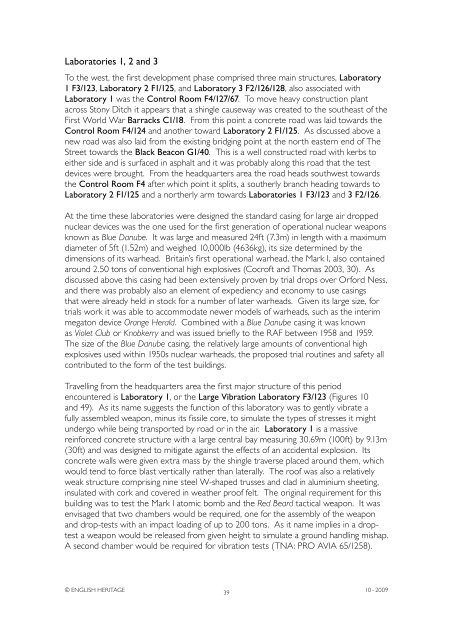Atomic Weapons Research Establishment. Orford ... - English Heritage
Atomic Weapons Research Establishment. Orford ... - English Heritage
Atomic Weapons Research Establishment. Orford ... - English Heritage
Create successful ePaper yourself
Turn your PDF publications into a flip-book with our unique Google optimized e-Paper software.
Laboratories 1, 2 and 3<br />
To the west, the first development phase comprised three main structures, Laboratory<br />
1 F3/123, Laboratory 2 F1/125, and Laboratory 3 F2/126/128, also associated with<br />
Laboratory 1 was the Control Room F4/127/67. To move heavy construction plant<br />
across Stony Ditch it appears that a shingle causeway was created to the southeast of the<br />
First World War Barracks C1/18. From this point a concrete road was laid towards the<br />
Control Room F4/124 and another toward Laboratory 2 F1/125. As discussed above a<br />
new road was also laid from the existing bridging point at the north eastern end of The<br />
Street towards the Black Beacon G1/40. This is a well constructed road with kerbs to<br />
either side and is surfaced in asphalt and it was probably along this road that the test<br />
devices were brought. From the headquarters area the road heads southwest towards<br />
the Control Room F4 after which point it splits, a southerly branch heading towards to<br />
Laboratory 2 F1/125 and a northerly arm towards Laboratories 1 F3/123 and 3 F2/126.<br />
At the time these laboratories were designed the standard casing for large air dropped<br />
nuclear devices was the one used for the first generation of operational nuclear weapons<br />
known as Blue Danube. It was large and measured 24ft (7.3m) in length with a maximum<br />
diameter of 5ft (1.52m) and weighed 10,000lb (4636kg), its size determined by the<br />
dimensions of its warhead. Britain’s first operational warhead, the Mark I, also contained<br />
around 2.50 tons of conventional high explosives (Cocroft and Thomas 2003, 30). As<br />
discussed above this casing had been extensively proven by trial drops over <strong>Orford</strong> Ness,<br />
and there was probably also an element of expediency and economy to use casings<br />
that were already held in stock for a number of later warheads. Given its large size, for<br />
trials work it was able to accommodate newer models of warheads, such as the interim<br />
megaton device Orange Herald. Combined with a Blue Danube casing it was known<br />
as Violet Club or Knobkerry and was issued briefly to the RAF between 1958 and 1959.<br />
The size of the Blue Danube casing, the relatively large amounts of conventional high<br />
explosives used within 1950s nuclear warheads, the proposed trial routines and safety all<br />
contributed to the form of the test buildings.<br />
Travelling from the headquarters area the first major structure of this period<br />
encountered is Laboratory 1, or the Large Vibration Laboratory F3/123 (Figures 10<br />
and 49). As its name suggests the function of this laboratory was to gently vibrate a<br />
fully assembled weapon, minus its fissile core, to simulate the types of stresses it might<br />
undergo while being transported by road or in the air. Laboratory 1 is a massive<br />
reinforced concrete structure with a large central bay measuring 30.69m (100ft) by 9.13m<br />
(30ft) and was designed to mitigate against the effects of an accidental explosion. Its<br />
concrete walls were given extra mass by the shingle traverse placed around them, which<br />
would tend to force blast vertically rather than laterally. The roof was also a relatively<br />
weak structure comprising nine steel W-shaped trusses and clad in aluminium sheeting,<br />
insulated with cork and covered in weather proof felt. The original requirement for this<br />
building was to test the Mark I atomic bomb and the Red Beard tactical weapon. It was<br />
envisaged that two chambers would be required, one for the assembly of the weapon<br />
and drop-tests with an impact loading of up to 200 tons. As it name implies in a droptest<br />
a weapon would be released from given height to simulate a ground handling mishap.<br />
A second chamber would be required for vibration tests (TNA: PRO AVIA 65/1258).<br />
© ENGLISH HERITAGE<br />
39<br />
10 - 2009

















